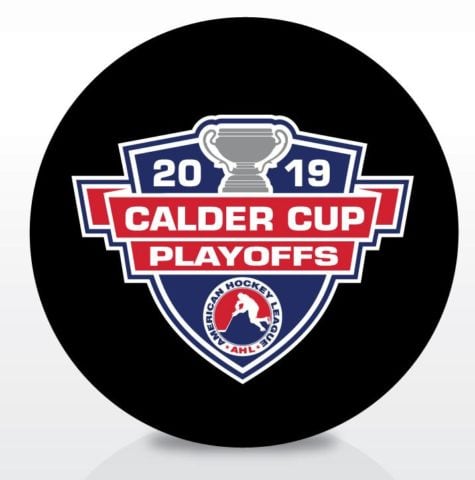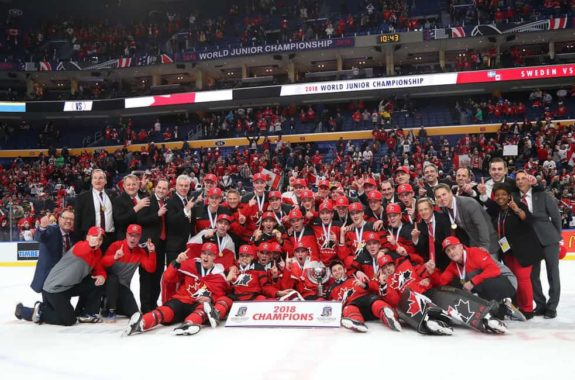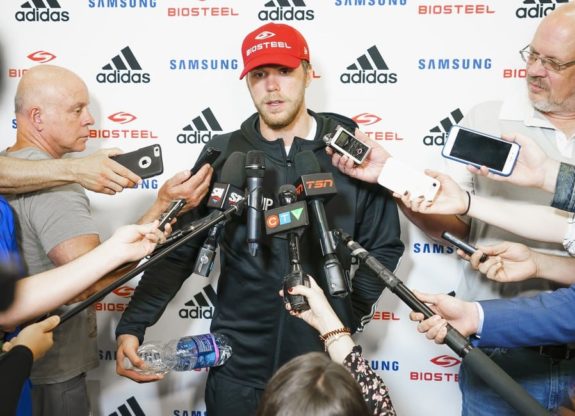Although the in-game exploits of the respective sports differ greatly, many comparisons can be drawn between baseball and ice hockey. Almost all of these comparisons reside at the major league organizational level. While one plays on ice and one on grass, the front office antics of the two sports are more similar than you think.
One area where the two sports find common ground is in player development, namely their minor league system. Earlier this month, Travis Sawchik wrote an article “Do We Even Need Minor League Baseball?” that paints America’s pastime’s minor league approach as an outdated an inefficient system. Some of the points and examples that Sawchik illuminates can be applied to player development for the sport of ice hockey. The real question is, should they be?
What’s Wrong with Minor League Baseball?
Much like hockey, minor league baseball fields teams of young prospects, mostly in areas where there are no big league clubs to draw fans and attention. Also like hockey, there are varying levels that players can move up through. While hockey namely has the ECHL and AHL feeding into the NHL, the layers and levels of baseball are a lot more complex. Sawchick argues that the amount of teams is unnecessary, and the long distances from their parent clubs create a disconnect that leads to delayed and staggered player development. Simply put, it’s not efficient and there must be a better way.

The Proposed Solution
Sawchick takes a cue from European soccer in his proposed solution. Major European soccer clubs don’t use minor leagues as a way of player development, yet focus their attention on prospects at a centralized training facility. No matter your level of experience, all roads lead through the same training facility. The Houston Astros, the team singled out by Sawchick in his case study, took notice:
“On site in Barcelona, they have their whole development academy, from the little kids all the way up to the professional teams. They have one big campus. They do everything on-site. Everything is coordinated. Everyone is doing the same drills. Everyone was being measured with the same technology. That makes a ton of sense,” the ex-Astros front official said.
Taking another look at the Astros playbook, Sawchick saw that they were rapidly increasing data collection from their players. This was done through a variety of ways, such as high-speed cameras and data trackers in equipment. Although fellow major league baseball clubs are starting to adopt the technology, the Astros have been at it for years.
Let’s assume for a moment that the NHL and its member clubs wanted to put forth a similar scenario. A multitude of AHL and ECHL teams would close up shop. Once a player gets drafted, they would report directly to the team that owns their rights for training. Namely, instead of going off to develop at a lower level, whether that be junior, minor or college level, they become reserves and recruits for the main team.
Why it Wouldn’t Work
While the model Sawchick puts forward makes some sense in the baseball world, it leaves out one major, longstanding factor of the North American ice hockey landscape: junior hockey. Long before players become “property,” for lack of a better word, of an NHL team, they most likely play at a junior league level that combines most of the elements that Sawchick put forward in his European training center example. Unlike the old days, major junior teams lack affiliation with NHL member clubs.

The main takeaway from Sawchick’s article is that there are just too many minor league baseball teams, and major league clubs should consolidate at the least. Meanwhile, the NHL and its member teams have far fewer minor league teams. Each NHL team seems to be affiliated with two minor league teams, at the most, with a select few lacking affiliation in the ECHL entirely. Meanwhile, Sawchick’s specific example of the Astros had them sizing down from nine minor league affiliates to seven.
And if the idea of advanced training labs and a centralized sports campus seemed familiar, you would be onto something. NHL teams have been increasing their usage of previously untapped data metrics, some leading toward the “money puck” movement. Arizona Coyotes general manager John Chayka was an early proponent at the NHL level. Although the NHL is still a ways away from a Billy Beane Oakland A’s type data-driven operation, they are inching closer towards it every season
While NHL teams might not have their own “campus” for athletes, numerous types of programs exist in the hockey world. While it may not operate year round, the annual BioSteel camp in Toronto replicates the vision of European soccer campuses, where athletes and prospects combine for the same workouts and drills. Meanwhile, stateside, the U.S. National Team Development Program may not combine players of different skill sets, yet the goal of integrating them into the national team is the same. Prospects also routinely play in a number of high-profile preseason tournaments, such as the Traverse City Prospect Tournament. There are other tournaments such as The Hlinka Gretzky Cup.

What About College?
College hockey was also completely left out of the equation. This is something that Sawchick can’t be entirely faulted for, as the pipeline of college to professional baseball is different than the pipeline of college to professional hockey. Although the same system of drafting and holding draft rights for a few years is similar, a large number of baseball players skip college entirely to get a head start on a minor league career. In hockey, if you’re good enough to play professional right away, there’s even less of a chance you considered college.
Attendance Problems
Although not an issue brought up by Sawchick, it’s hard to imagine part of his argument wasn’t motivated by attendance problems in all levels of baseball. While some hockey teams and leagues have problems of their own, there are a number of junior and minor teams that drive sizable crowds. Perhaps it’s due to baseball’s over-saturation of teams and overabundance of their own product, as hockey is more of a rare find, especially in niche markets.
Minor League Hockey Is Fine
While Major League Baseball is making leaps and bounds in their data collection, it’s nothing that hockey isn’t in the process of doing already. Hockey might have some catching up to do in the player data department, but they’re on their way. Most importantly, minor league hockey should stay the way it is because of the value it delivers to fans. The word “value” could mean anything and everything from the price of a ticket to the overall game experience. In the small remote towns of Canada and the United states, even if it’s not major league, the fans love their hockey. Decreasing the minor league and junior teams would be a disservice to the fans, who keep the entire sport in business at all levels.